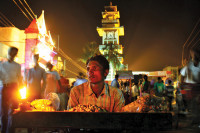Miscellaneous
More than half the sky
Despite their hard work millions of rural women are still socially disadvantaged
Fond memories of riding horses with father, helping mother to dry firewood, listening to spooky stories snuggled in grandma’s lap and chanting lord Shiva’s stotram with grandpa and making cow dung cakes with my only best ‘rural’ friend Malati Yadav still warms my heart.
I am now using the term ‘rural’ on purpose, because these days Malati is officially categorised as a rural Nepali woman. Recently, I was reminded of Malati when a colleague asked me about rural women and agriculture because he was designing infographics for the International Day of Rural Women. This day was first observed on October 15, 2008, following the UN General Assembly resolution 62/136 of December 18, 2007. The resolution recognises the critical role and contribution of rural women, including indigenous women in enhancing agricultural and rural development, improving food security and helping eradicate rural poverty.
Indispensable providers
After sharing some facts and figures with my colleague, I started ruminating about what makes women rural? According to the UN, women who live in rural areas and work as farmers, petty traders, artisans, industrial home workers, micro-producers and domestic servants are termed as ‘rural’ women. And by this definition, Malati is a rural woman. One of the latest reports of Care International states that female labour force participation in Nepal is 54.3 percent and 78 percent of economically active women are engaged in agriculture. These so-called rural women are the ones who actually help to bring food to our dining table every day and make a critical contribution to national food security.
For instance, International Center for Research on Women reports that rural women all around the globe produce half of the world’s food. Further, in developing countries women grow between 60 and 80 percent of food crops. However, it is a pity that a large number of economically active women in many Asian and African countries have no control of various productive assets, including land. According to global gender and land rights database of the Food and Agriculture Organi-sation (FAO), in 2011 sole female land ownership in Nepal was just 10 percent. Various FAO reports claim that if rural women had equal access to productive resources as men, then the number of hungry people in the world would be reduced by 100 to 150 million.
Two different lives
I met Malati 32 years ago while I was visiting my grandfather’s farm in Sunsari district during my summer break. My grandpa used to be the jamindar of the village then. Malati and I would collect cow dung and make cakes for cooking fuel. Malati taught me Maithili and I helped her with a few English words. We used to steal raw mangos and hide in the bhakari (household seed bank made of straw and mud). I vividly remember running with her in the earthen canal of the paddy fields and dancing along the blade of grass. Malati used to be a very happy child. More than three decades have gone by, and we still have some commonalities. We are both married and blessed with kids for example. However, a major difference between us is the level of education we acquired. She had to drop out from higher secondary school because she was forced to get married by her parents. Recently, I learned she struggled hard to arrange some cash to send her daughter to college. But I could hear happiness and pride in her voice when Malati shared the great news of her daughter going to college on the phone.
As I shared this story with my colleague, I secretly paid tribute to millions of Malati like rural women out there, who have spent many years sacrificing their childhood innocence and adolescent enthusiasm in their parents’, jamindars’ and in-laws’ farms doing various agricultural hardships. Regrettably, many rural women like Malati still do not own the land they till, weed, plant, plough, irrigate and harvest. They cannot even freely utilise the land they inherit from their parents.
While working on the infographics to mark the International Day for Rural Women, I wondered if this was the best way to the millions of Malatis out there. Probably, the question for the broader development community would be: how can we leverage scientific and technological expertise to meet the growing demand of food while maintaining crop diversity, sustainability and helping millions of rural women raise their household incomes?
Upadhyay is a development practitioner




 21.12°C Kathmandu
21.12°C Kathmandu









